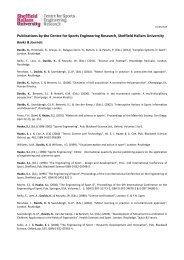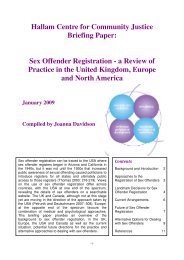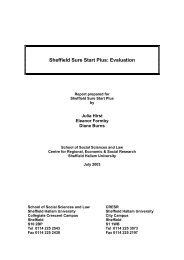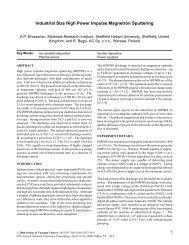The exercise of judicial discretion in rent arrears cases - Sheffield ...
The exercise of judicial discretion in rent arrears cases - Sheffield ...
The exercise of judicial discretion in rent arrears cases - Sheffield ...
Create successful ePaper yourself
Turn your PDF publications into a flip-book with our unique Google optimized e-Paper software.
such forms are completed <strong>in</strong> less than a quarter <strong>of</strong> <strong>cases</strong>, <strong>in</strong> part due to the length and<br />
complexity <strong>of</strong> the forms.<br />
<strong>The</strong> papers will be issued by the court with a fixed return date for the hear<strong>in</strong>g. Unlike many<br />
other court actions there will be no prelim<strong>in</strong>ary hear<strong>in</strong>g, rather courts will generally have<br />
possession hear<strong>in</strong>gs listed on a regular basis. <strong>The</strong> exact details will depend on the number<br />
<strong>of</strong> actions the court has entered, but typically <strong>in</strong> a medium sized county court a possession<br />
list will be heard one morn<strong>in</strong>g a week. Aga<strong>in</strong> list<strong>in</strong>g practices may vary between courts, but it<br />
is not unusual for around 40 - 50 <strong>cases</strong> to be listed <strong>in</strong> a morn<strong>in</strong>g.<br />
Cases are heard by district judges. As at 1 December 2004 there were 415 district judges<br />
and 748 deputy district judges <strong>in</strong> the county court (DCA, 2004). It is not uncommon for<br />
hous<strong>in</strong>g possession <strong>cases</strong> to be listed <strong>in</strong> front <strong>of</strong> deputy district judges.<br />
<strong>The</strong> use <strong>of</strong> possession <strong>in</strong> <strong>rent</strong> <strong>arrears</strong> <strong>cases</strong><br />
<strong>The</strong> use <strong>of</strong> court proceed<strong>in</strong>gs to deal with possession has <strong>in</strong>creased alongside the levels <strong>of</strong><br />
<strong>arrears</strong>, although for the first time <strong>in</strong> 10 years the numbers reduced <strong>in</strong> 2003. Table 1 sets<br />
out the numbers <strong>of</strong> court actions for possession issued by social landlords <strong>in</strong> England and<br />
Wales, together with the number <strong>of</strong> outright and suspended possession orders granted.<br />
In seek<strong>in</strong>g to expla<strong>in</strong> these <strong>in</strong>creases, Pawson et al (2005) asked social landlords what were<br />
the most important factors <strong>in</strong> this change. <strong>The</strong> most common response (which was<br />
particularly dom<strong>in</strong>ant amongst local authorities) was “policy and practice changes <strong>of</strong> (our)<br />
organisation.” Thus from their perspective <strong>in</strong>creas<strong>in</strong>g possession actions were be<strong>in</strong>g driven<br />
by the landlord, rather than any change <strong>in</strong> legal policy or procedure. <strong>The</strong> court records do<br />
not necessarily <strong>in</strong>dicate that evictions have been ris<strong>in</strong>g, as they only record orders made.<br />
Other data analysed by Pawson et al, does, however, seem to suggest that the <strong>in</strong>creas<strong>in</strong>g<br />
numbers <strong>of</strong> eviction actions is also lead<strong>in</strong>g to a larger number <strong>of</strong> actual evictions.<br />
10
















